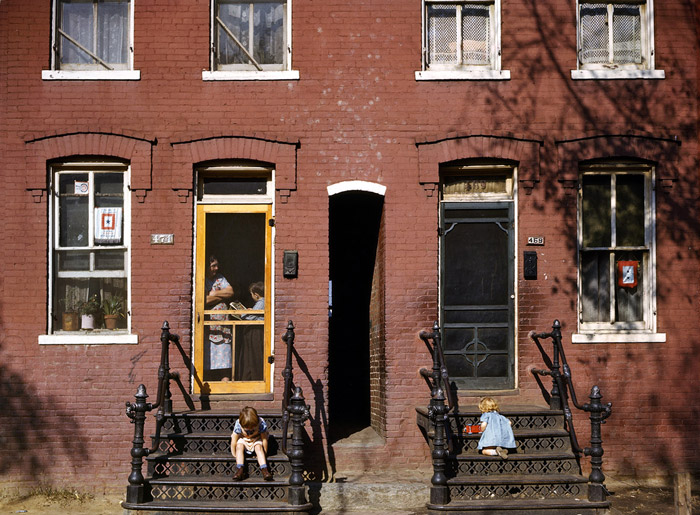Step Children
Dec 13, 2012
 During World War II, service flags like the ones hanging in these windows, could be seen in houses all over America. Within the red border of the window-hanging was sewn a blue star for each family member serving in the military. Gold stars acknowledged those killed in action.
During World War II, service flags like the ones hanging in these windows, could be seen in houses all over America. Within the red border of the window-hanging was sewn a blue star for each family member serving in the military. Gold stars acknowledged those killed in action.
The steps these children were playing on in 1942, along N Street SW in Washington, DC, were bulldozed a dozen or so years later as part of one of the country's largest "urban renewal" projects. All the residential and commercial neighborhoods in the city south of the national mall were condemned and all the residents evicted. The buildings were torn down and even much of the street grid scraped away, as a team of builders and designers led by I.M. Pei sought to start over from scratch, to create a 1950s-style urban utopia.
Before the urban renewal, Southwest Washington had been home to several generations of European immigrants and African American migrants from the South. Irish, Italian and Eastern European immigrants, possibly including these families, lived in the neighborhood west of Fourth Street SW, which was then known as Four and a Half Street. The street addresses here would have been very near Four and a Half Street. East of that street, mostly in more decrepit houses, lived African Americans, some of whom had come to Washington as freed slaves before or soon after the Civil War. The two adjacent neighborhoods both produced musical stars in the twentieth century: Marvin Gaye and Al Jolson.
Urban renewal wiped away all the homes, schools, stores, and other buildings except for one church, a fish wharf, and Bolling Air Force Base. A freeway was built through the middle of the new emptiness, with office complexes and new apartment buildings on either side. The project went the way of much mid-century city planning: people did come to work in the office buildings but went home every night as soon as they could, and people did live in the apartments but got in their cars and drove away to shop, play, and generally live their lives. Except at rush hour, neighborhood streets were empty.
It took another half-century, until 2003, before Southwest Washington got its first real grocery store. There has been something of a revival in recent years, as new stores opened and area parks were developed, giving people a reason to go outside and walk around. New apartment and condo projects have increased neighborhood density.
What happened to the thousands of people who were expelled from Southwest in the 1950s, possibly including the people in this picture? I'm not aware that anyone has kept track of them. Not to belittle their fate, but in one way or another, what happened to them happened to millions of Americans throughout the last century. In America, city people rarely stay put in the same neighborhoods generation after generation. People change and seek out different kinds of neighborhoods, and/or the neighborhoods change, pushing people out or leaving them uncomfortable and precariously clinging to homes in places that aren't what they used to be.